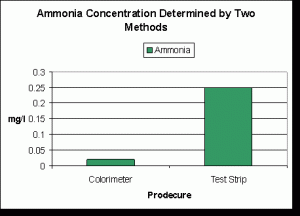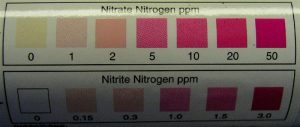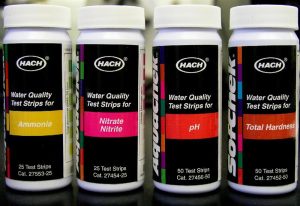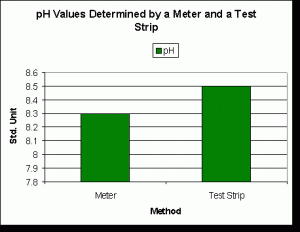This month’s Product Review discusses the relative merits of different methods of water quality testing. One set of methods (test strips) is quick, convenient, and relatively inexpensive, while the other (titration) offers precision well beyond that of many ‘test kits’ normally seem in the aquarium hobby.
How reliable are the results of ‘test strips’? Is there any advantage in using them? On the other hand, what of the precise results offered by Hach’s Digital Titrator – Is the precision worth the price?
Reefkeeping was once a hobby of those with large amounts of discretionary income. Times have changed – tried-and-true methods and a better understanding of biological requirements of various reef animals have allowed ‘nano-reefs’ to gain popularity. A small fortune is not required to maintain tropical fishes and invertebrates, but we should be constantly refining our techniques to make the reef hobby truly affordable. To this end, do ‘test strips’ fill the gap between sometimes pricey water quality monitoring and none at all?
The first question is obviously one of utility – Do these strips work in saltwater? The answer is ‘yes’ (at least for those tested, which includes pH, nitrite/nitrate and ammonia).
All ‘test strips’ were purchased through normal retail channels, and their performance was evaluated by at least two observers, and the perceived results were then compared to values obtained by ‘laboratory-grade’ equipment, including two calibrated pH meters, and in the case of nutrients, a colorimeter and a spectrometer.
These were the results:
pH
pH (saltwater)
- Range: 4 – 9 standard units
- Shelf Life: 19 months
- Number of Tests: 50
- Price: $7.99
- Hach Catalog Number: 27456-50
- Cost per Test (excluding shipping and applicable taxes): 16¢
- Cost per Test (purchased through normal ‘pet’ retail channels): 17¢
- Value Estimated by Two Observers of the Test Strips in saltwater: ‘Between 8 and 9’, and ‘8.5’.
- Actual pH, saltwater = 8.288 (as measured with a Hach HQ40d meter and calibrated pH probe).
pH (freshwater)
- Value Estimated by Two Observers of the Test Strips in freshwater: ‘About 7’, ‘7.5’, ‘7.0’ and ‘6.5’.
- Actual pH, freshwater = ‘7.16’, ‘7.33’, ‘7.11’, and ‘7.19’, respectively (As measured with a calibrated Denver Instrument pH meter and pH probe).
Comments on pH Test Strips
The pH strips performed reasonably well under the conditions of the testing. Based on these observations, it is believed that these test strips would be of benefit, especially when rapid results are required (as in troubleshooting). Do not use pH standards (4.0, 7.0, 9.0, etc.) to check!
Ammonia
Total Ammonia (Sum of Ammonia and Ammonium)
- Range 0 – 6 mg/l
- Shelf Life: 22 months
- Number of Tests: 25
- Price: $15.99
- Hach Catalog Number: 27553-25
- Cost per Test (excluding shipping and applicable taxes): 64¢
- Cost per Test (purchased through normal ‘pet’ retail channels): 24¢
Test Strips – Ammonia (Low Range)
Value Estimated by Two Observers of the Test Strips: 0.25 and 0.25 mg/l.
Actual Ammonia Measurement (as NH3-N): 0.02 mg/l, as measured with a Hach DR 890 colorimeter and prepackaged reagents.
Test Strips – Ammonia (High Range)
Value Estimated by One Observer of the Test Strips: ‘1.4’, ‘0.5’, ‘0.75’, and ‘0.75’ mg/l, respectively.
Actual Ammonia Measurement (as NH3-N): ‘1.5’, ‘0.9’, ‘1.3’, and ‘0.9’ mg/l, as measured with a Hach DR2010 spectrometer and prepackaged reagents.

Figure 2. Averaged values of the low range ammonia measurements (in seawater) compared to the concentration determined by a Hach colorimeter.
Comments on Ammonia Test Strips
The ammonia test strips turn blue-green when the maximum concentration is exceeded. They are sometimes difficult to read, and consistently reported ammonia concentrations higher than those tested with either a colorimeter or spectrometer.
These could be of benefit when ‘cycling’ a tank, and, again, could be of use in determining which path to follow when diagnosing aquarium problems.
One small test tube, along with two additional tubes for multiple testing or spares, is included with the test strips.
Nitrite and Nitrate
Test Strips – Nitrite and Nitrate
- Nitrite Range (as NO2-N): 0 – 3.0 milligrams per liter
- Nitrate Range (as NO3-N): 0 – 50 milligrams per liter
- Shelf Life: 22 months
- Number of Tests: 25
- Price: $13.99
- Hach Catalog Number: 27454-25
- Cost per Test (excluding shipping and applicable taxes): 28¢ each for nitrite and nitrate.
- Cost per Test (purchased through normal ‘pet’ retail channels): 28¢ each for nitrite and nitrate.

Figure 3. The ranges for nitrate and nitrite are of interest to those hobbyists ‘cycling’ an aquarium and for quick spot checks.
Test Strips – Nitrites (Low Range)
Value Estimated by Two Observers of the Test Strips: Zero.
Actual Nitrite Measurement (as NO2-N): 0.011 mg/l, as measured with a Hach DR 890 colorimeter and prepackaged reagents.
Test Strips – Nitrites (High Range)
Value Estimated by Observer of the Test Strips: ‘2’, ‘1’ and ‘1’ mg/l, respectively.
Actual Nitrite Measurement (as NO2-N): ‘0.95’, ‘0.63’ and ‘0.685’ mg/l, as measured with a Hach DR 2010 spectrometer and prepackaged reagents.
Comments on the Nitrite Test Strips
Under the conditions of these trials, the strips for testing nitrites performed reasonably well. These would be useful for spot checks and rapid data generation when diagnosing a problem.
Nitrates are generally considered the last step of aerobic nitrogen conversion in the ‘nitrogen cycle.’ Therefore, nitrates tend to accumulate in aquaria water unless some sort of export mechanism is employed (anaerobic denitrification, water changes, algal uptake, etc.).
Test Strips – Nitrates (Low Range)
Value Estimated by Two Observers of the Test Strips: ‘Between 1 and 2 mg/l’ and ‘Between 2 and 5 mg/l.’
Actual Nitrate Measurement (as NO3-N): 3.6 mg/l
Test Strips – Nitrates (High Range)
Value Estimated by Two Observers of the Test Strips: ‘Between 1 and 2 mg/l’ and ‘Between 2 and 5 mg/l.’
Actual Nitrate Measurement (as NO3-N): 3.6 mg/l.
Comments on Nitrite/Nitrate Test Strips
Generally, these strips reported values lower than those obtained with the laboratory instruments. This could be due to the presence of chlorides in the saltwater (chlorides exceeding 100 mg/l cause low results). However, nitrate is the least toxic when compared to ammonia or nitrite. The results of these test indicates the test strips have some utility in checking aquarium water.
Total Hardness
Test Strips – Total Hardness
- Range: 0 – 425 parts per million (roughly equivalent to milligrams per liter) and 0 – 25 grains per gallon.
- Shelf Life: 34 months
- Number of Tests: 50
- Price: $7.99
- Catalog Number: 27452-50
- Cost per Test (excluding shipping and applicable taxes): 16¢
Comments on Total Hardness Test Strips
Total Hardness is generally considered to be the sum of hardness contributed by two elements – calcium and magnesium (although other elements, such as strontium, can contribute to total hardness). Normal concentrations of calcium and magnesium in seawater exceed the upper limit of the test range (natural seawater’s total hardness exceeds 6,000 mg/l as CaCO3). Dilution of the sample is therefore required. Mixing 4 milliliters of sample in 96 ml of distilled water should get the saltwater within the range of the test strip (actual Total Hardness should be ~240 mg/l as CaCO3). Even then, the increments of the test strip do not have the fine-scale resolution to accurately judge Total Hardness should the measurement be higher, or lower.
The Total Hardness Test Strips are not designed for testing hardness normally seen in saltwater aquaria. They might be of benefit for freshwater hobbyists, or perhaps for ‘spot-checking’ RO effluents or tap water.
The test strips (reviewed above) offer only a general sense of concentration, but Hach’s Digital Titrator delivers fine resolution. The Digital Titrator is likely of interest for those looking for a precise method of determining several different water quality parameters. Those tests of most interest to reefkeepers include Total Sequential Hardness (which in turn quantifies Calcium Hardness and Magnesium Hardness), Alkalinity, and Carbon Dioxide (if you’re maintaining a calcium reactor on a reef tank or have a CO2 injection system on a planted freshwater aquarium). Other ‘specialty’ parameters can also be measured, including Chlorides and Acidity. Although Iron and Nitrite concentrations can be determined, the sensitivity of the methodologies does not allow proper resolution, and the lower detectable limits are well above those normally seen in aquaria (Hach’s colorimeters and spectrometers, however, are superb at measuring extremely low concentrations of nitrite, iron and many others. See a Product Review of the Hach 800 series colorimeters at www.advancedaquarist.com/2005/6/review/).
The Digital Titrator (see Figure 4) is a manually operated device, and is very simple to use. A delivery tube is placed in a plastic cartridge (containing an appropriate reagent), which is then attached to the titrator. The operator turns a knob on the titrator, which pushes a plunger within the reagent cartridge, thus delivering small amounts of reagent to the test sample. The titrator is capable of finer resolution than a ‘drop-count’ method. For instance, the drop count method generally dispenses one drop at a time (1 milliliter is usually considered to contain ~20 drops (~0.05 milliliter of reagent); the digital titrator delivers 0.00125 milliliter per digit – 40X more precise than the ‘drop count’ method!
Although any light source can be used while visually judging colorimetric titration endpoints, use of a full spectrum fluorescent lamp is recommended.
Digital Titrator Options
Hach offers a couple of options when purchasing a Digital Titrator.
The first option is the ‘no-frills’ offering:
- Hach Catalog Number: 16900-01
- Price: $114.00 (includes case, manual and 5 straight delivery tubes).
Hach also has a Digital Titrator ‘Kit’, which, in addition to everything in the no-frills package, also includes a 100 ml graduated cylinder, 125 ml and 250 ml Erlenmeyer flasks, a demineralization bottle and clippers. The price is $199.00, and the catalog number is 2270900. Consider pricing these flasks and cylinder separately for potential savings.
Additional ‘J’ delivery tubes: Hach Catalog Number 17205-00, Price: $6.20
As mentioned, there are several tests of interests to aquarists that the Titrator can perform. These include:
Digital Titrator – Alkalinity
- Range: 10 – 4,000 mg/l
- Catalog Number: 2271900
- Price: $49.80
- Cost per Test (assuming 100 tests): ~50¢
- Cost per Test (purchased through normal ‘pet’ retail channels): 32¢
Digital Titrator – Total Sequential Hardness (calcium and magnesium)
- Range: 0 – 4,000 mg/l
- Catalog Number: 2272100
- Price: $77.90
- Cost per Test (assuming 16 tests*): $2.43 each for calcium and magnesium.
- Cost per Calcium only Test (purchased through normal ‘pet’ retail channels): 56¢
* Number of tests based on calcium levels of ~400 mg/l and magnesium at ~1,200 mg/l, using a sample of 5 milliliters diluted to 100 ml with distilled water and a reagent cartridge of an 0.800M EDTA.
Digital Titrator -Carbon Dioxide
- Range: 0-100 mg/l
- Catalog Number: 2443700
- Price: $24.60
- Cost per Test (assuming 100 tests): 25¢
Conclusions – Digital Titrator
Hach’s Digital Titrator will fit the bill for those hobbyists or professional aquarists wanting or requiring the ‘ultimate’ in wet chemistry analytical methodology. The resolution is fine enough to establish diurnal trends. The main detraction is the cost associated with the Digital Titrator and associated reagents. Other lab ware makes using the Titrator much easier (these items include a magnetic stirrer and stir bar, glass flasks or beakers, etc.). These items are available from Hach, or in used condition and are available on EBay, or dealers in used laboratory equipment such as www.LabX.com .
Every effort has been made to present information that is correct at the time of writing. As with all products, specifications, prices and availability can change. For the latest information, visit www.hach.com. Any questions should be directed to me at [email protected].
Reference
- American Public Health Association, 1998. Standard Methods for the Examination of Water and Wastewater, 20th Edition. Edited by L. Clesceri, A. Greenberg and Andrew Eaton. Baltimore.






There has been many postings on a koi sight that say test strips are unreliable compared to IPA drop freshwater test kits. But I have found test strips to be just as accurate as the IPA drop test kits?